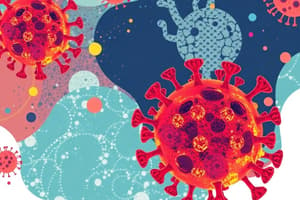Podcast
Questions and Answers
What is the primary focus of virology?
What is the primary focus of virology?
- Study of viruses and virus-like agents (correct)
- Study of immune responses
- Study of bacteria and fungi
- Study of cellular organisms
Which characteristic is true about viruses?
Which characteristic is true about viruses?
- They can replicate outside a host cell
- They contain cells
- They have a complex cellular structure
- They are obligate intracellular parasites (correct)
What type of viruses contain RNA as their genetic material?
What type of viruses contain RNA as their genetic material?
- RNA Viruses (correct)
- Polymerase Viruses
- DNA Viruses
- Chromosomal Viruses
Which mode of transmission involves contact with contaminated surfaces?
Which mode of transmission involves contact with contaminated surfaces?
What is the first step of the viral replication cycle?
What is the first step of the viral replication cycle?
Which component represents the innate immune response?
Which component represents the innate immune response?
What type of therapeutic approach uses laboratory-made antibodies?
What type of therapeutic approach uses laboratory-made antibodies?
Which of the following is a challenge faced in virology?
Which of the following is a challenge faced in virology?
Flashcards are hidden until you start studying
Study Notes
Definition of Virology
- Virology is the study of viruses and virus-like agents.
- Focuses on their structure, classification, evolution, methods of infection, and interaction with host organisms.
Characteristics of Viruses
- Acellular: Viruses are not made up of cells.
- Structure: Consist of genetic material (DNA or RNA) enclosed in a protein coat (capsid).
- Size: Typically ranges from 20 to 300 nanometers.
- Obligate intracellular parasites: Can only replicate inside a host cell.
Types of Viruses
- DNA Viruses: Contain DNA as their genetic material.
- Examples: Herpesviruses, Adenoviruses.
- RNA Viruses: Contain RNA as their genetic material.
- Examples: Influenza viruses, Coronaviruses.
- Retroviruses: RNA viruses that reverse transcribe their RNA to DNA.
- Example: HIV.
Modes of Transmission
- Direct contact (person-to-person).
- Airborne transmission (inhalation of droplets).
- Vector-borne transmission (via insects).
- Fomite transmission (contaminated surfaces).
Viral Replication Cycle
- Attachment: Virus binds to the host cell's surface receptors.
- Penetration: Virus enters the host cell, either by fusion or endocytosis.
- Uncoating: Viral genetic material is released into the host cell.
- Replication and Transcription: Host machinery is used to replicate viral nucleic acids and produce viral proteins.
- Assembly: Newly formed viruses are assembled from genetic material and proteins.
- Release: New viruses leave the host cell, either by lysis or budding.
Host Immune Response
- Innate Immune Response: First line of defense; includes physical barriers, cells (e.g., macrophages), and cytokines.
- Adaptive Immune Response: Involves T cells and B cells, leading to the production of antibodies against the virus.
Therapeutic Approaches
- Antiviral drugs: Target specific viral replication processes (e.g., reverse transcriptase inhibitors for HIV).
- Vaccines: Stimulate the immune system to recognize and respond to specific viruses.
- Monoclonal antibodies: Laboratory-made antibodies to neutralize viruses.
Challenges in Virology
- Rapid mutation rates of viruses, leading to challenges in vaccine development.
- Emerging viral diseases (e.g., zoonotic viruses) and outbreaks.
- Antiviral resistance.
Applications of Virology
- Clinical virology: Diagnosis and treatment of viral infections.
- Molecular virology: Understanding virus-host interactions and viral genomics.
- Biotechnology: Using viruses as vectors in gene therapy and vaccine development.
Virology
- The study of viruses and virus-like agents.
- Focuses on their structure, classification, evolution, methods of infection, and interaction with host organisms.
Characteristics of Viruses
- Acellular: Not made up of cells.
- Structure: Contain genetic material (DNA or RNA) enclosed in a protein coat (capsid).
- Size: Typically range from 20 to 300 nanometers.
- Obligate intracellular parasites: Can only replicate inside a host cell.
Types of Viruses
- DNA Viruses: Contain DNA as their genetic material. Examples include Herpesviruses and Adenoviruses.
- RNA Viruses: Contain RNA as their genetic material. Examples include Influenza viruses and Coronaviruses.
- Retroviruses: RNA viruses that reverse transcribe their RNA to DNA. Example: HIV.
Modes of Transmission
- Direct contact: Person-to-person.
- Airborne transmission: Inhalation of droplets.
- Vector-borne transmission: Via insects.
- Fomite transmission: Contaminated surfaces.
Viral Replication Cycle
-
Attachment: Virus binds to host cell surface receptors.
-
Penetration: Virus enters the host cell, either by fusion or endocytosis.
-
Uncoating: Viral genetic material is released into the host cell.
-
Replication and Transcription: Host machinery is used to replicate viral nucleic acids and produce viral proteins.
-
Assembly: Newly formed viruses are assembled from genetic material and proteins.
-
Release: New viruses leave the host cell, either by lysis or budding.
Host Immune Response
-
Innate Immune Response: First line of defense; includes physical barriers, cells (e.g., macrophages), and cytokines.
-
Adaptive Immune Response: Involves T cells and B cells, leading to the production of antibodies against the virus.
Therapeutic Approaches
-
Antiviral drugs: Target specific viral replication processes (e.g., reverse transcriptase inhibitors for HIV).
-
Vaccines: Stimulate the immune system to recognize and respond to specific viruses.
-
Monoclonal antibodies: Laboratory-made antibodies to neutralize viruses.
Challenges in Virology
- Rapid mutation rates of viruses: Leading to challenges in vaccine development.
- Emerging viral diseases: (e.g., zoonotic viruses) and outbreaks.
- Antiviral resistance.
Applications of Virology
-
Clinical virology: Diagnosis and treatment of viral infections.
-
Molecular virology: Understanding virus-host interactions and viral genomics.
-
Biotechnology: Using viruses as vectors in gene therapy and vaccine development.
Studying That Suits You
Use AI to generate personalized quizzes and flashcards to suit your learning preferences.




